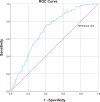Development of angle closure and associated risk factors: The Handan eye study
- PMID: 33960669
- PMCID: PMC9292978
- DOI: 10.1111/aos.14887
Development of angle closure and associated risk factors: The Handan eye study
Abstract
Purpose: To investigate the development of angle closure from baseline open angle and associated risk factors in a rural Chinese population through a longitudinal study over a 5-year period.
Methods: Subjects aged ≥30 years and older with bilateral open angles at baseline of the Handan Eye Study who participated in the follow-up and had undergone both baseline and follow-up gonioscopic examinations were included. Subjects with any form of angle closure, glaucoma, incisional ocular surgery or other conditions that could influence the results were excluded. The development of angle closure was defined as the presence of primary angle closure suspect (PACS) or primary angle closure (PAC)/primary angle closure glaucoma (PACG) during the follow-up in normal subjects with baseline bilateral open angles. Logistic regression was performed to identify the baseline risk factors for the development of angle closure.
Results: A total of 457 subjects with bilateral open angles at baseline aged 53.0 (45.5, 58.0) years were enrolled. 94.7% of the included cases developed PACS, 5.3% developed PAC and no one developed PACG after 5 years. In logistic regression, significant risk factors for the development of angle closure were shallower central anterior chamber depth (ACD) (p = 0.002) and narrower mean angle width (p < 0.001).
Conclusions: This study reports the development from baseline open angle to angle closure after a 5-year follow-up. We confirm that the mean angle width and central ACD were independent predictive risk factors for the development of any form of angle closure.
Keywords: development of angle closure; primary angle closure; primary angle closure glaucoma; primary angle closure suspect; risk factors.
© 2021 The Authors. Acta Ophthalmologica published by John Wiley & Sons Ltd on behalf of Acta Ophthalmologica Scandinavica Foundation.
Figures
Similar articles
-
Progression of Primary Angle Closure Suspect to Primary Angle Closure and Associated Risk Factors: The Handan Eye Study.Invest Ophthalmol Vis Sci. 2021 Jun 1;62(7):2. doi: 10.1167/iovs.62.7.2. Invest Ophthalmol Vis Sci. 2021. PMID: 34061952 Free PMC article.
-
Ten-year incidence of primary angle closure in elderly Chinese: the Liwan Eye Study.Br J Ophthalmol. 2019 Mar;103(3):355-360. doi: 10.1136/bjophthalmol-2017-311808. Epub 2018 May 18. Br J Ophthalmol. 2019. PMID: 29777045
-
Six-Year Incidence and Risk Factors for Primary Angle-Closure Disease: The Singapore Epidemiology of Eye Diseases Study.Ophthalmology. 2022 Jul;129(7):792-802. doi: 10.1016/j.ophtha.2022.03.009. Epub 2022 Mar 16. Ophthalmology. 2022. PMID: 35306094
-
Gonioscopy findings and prevalence of occludable angles in a Burmese population: the Meiktila Eye Study.Br J Ophthalmol. 2007 Jul;91(7):856-9. doi: 10.1136/bjo.2006.108688. Br J Ophthalmol. 2007. PMID: 17576708 Free PMC article. Review.
-
[Primary anterior chamber angle closure: progression from suspect to glaucoma. Part 1. Frequency and rate of transition from suspected primary angle closure to true angle closure and primary angle closure glaucoma].Vestn Oftalmol. 2022;138(4):101-107. doi: 10.17116/oftalma2022138041101. Vestn Oftalmol. 2022. PMID: 36004598 Review. Russian.
Cited by
-
Smartphone-Acquired Anterior Segment Images for Deep Learning Prediction of Anterior Chamber Depth: A Proof-of-Concept Study.Front Med (Lausanne). 2022 Jun 23;9:912214. doi: 10.3389/fmed.2022.912214. eCollection 2022. Front Med (Lausanne). 2022. PMID: 35814744 Free PMC article.
-
Detecting eyes with high risk of angle closure among apparently normal eyes by anterior segment OCT: a health examination center-based model.BMC Ophthalmol. 2022 Dec 28;22(1):513. doi: 10.1186/s12886-022-02739-7. BMC Ophthalmol. 2022. PMID: 36577987 Free PMC article.
-
Oxidative Stress: A Suitable Therapeutic Target for Optic Nerve Diseases?Antioxidants (Basel). 2023 Jul 20;12(7):1465. doi: 10.3390/antiox12071465. Antioxidants (Basel). 2023. PMID: 37508003 Free PMC article. Review.
-
Distribution of White-to-White Corneal Diameter and Anterior Chamber Depth in Chinese Myopic Patients.Front Med (Lausanne). 2021 Nov 18;8:732719. doi: 10.3389/fmed.2021.732719. eCollection 2021. Front Med (Lausanne). 2021. PMID: 34869427 Free PMC article.
-
Characteristics of beta parapapillary atrophy in primary angle-closure suspect.BMJ Open Ophthalmol. 2024 Apr 15;9(1):e001529. doi: 10.1136/bmjophth-2023-001529. BMJ Open Ophthalmol. 2024. PMID: 38626931 Free PMC article.
References
-
- Alsbirk PH (1992): Anatomical risk factors in primary angle‐closure glaucoma. A ten year follow up survey based on limbal and axial anterior chamber depths in a high risk population. Int Ophthalmol 16: 265–272. - PubMed
-
- Casson RJ, Baker M, Edussuriya K, Senaratne T, Selva D & Sennanayake S (2009): Prevalence and determinants of angle closure in central Sri Lanka: the Kandy Eye Study. Ophthalmology 116: 1444–1449. - PubMed
-
- Chylack LT Jr, Wolfe JK, Singer DM et al. (1993): The lens opacities classification system III. The longitudinal study of cataract study group. Arch Ophthalmol 111: 831–836. - PubMed
-
- Erie JC, Hodge DO & Gray DT (1997): The incidence of primary angle‐closure glaucoma in Olmsted County, Minnesota. Arch Ophthalmol 115: 177–181. - PubMed
Publication types
MeSH terms
Grants and funding
LinkOut - more resources
Full Text Sources
Other Literature Sources
Medical



